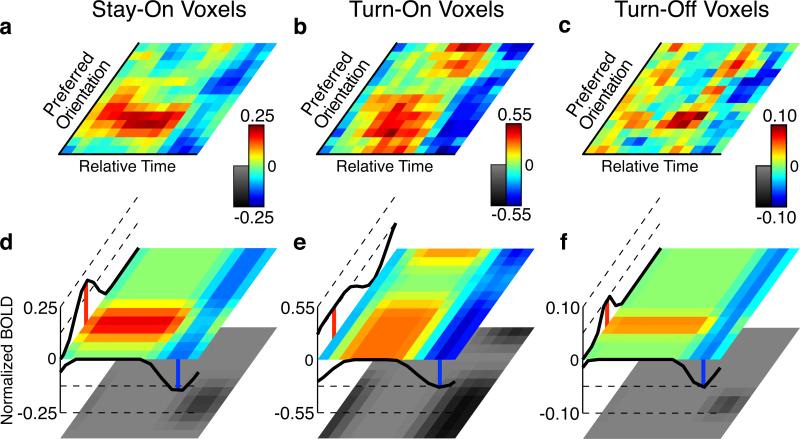7.
Attention model parameters from three separate groups of voxels are nearly identical. The optimal model (lowest BIC) is comprised of three attentional mechanisms: a feature-specific additive enhancement, a time-specific subtractive inhibition, and an inhibitory interaction term which gates the feature-attention to the relevant period of time. A. The empirical attention surface generated from Stay-On (SO) voxels, computed as the difference between the Attend and No-Cue activity surfaces. Variance that is explained by global changes in activity over all voxels (the trend line in Fig. 5) has been removed. The middle of this surface represents the cued orientation/time. B, C. As A, showing the attention surfaces generated from Turn-On (ON) and Turn-Off (OFF) voxels. All surfaces show an increase in activity within voxels that prefer an orientation just prior to the cue, and all surfaces show a global suppression after the stimulus passes the cued orientation. D. The best-fitting model surface for the SO voxel attention surface. Curves along the left and bottom sides show the modeled featurally and temporally specific modulations, while the black-and-white surface shows the feature-time interaction term (always suppressive). The sum of all three attentional mechanisms provides the colored model surface. E, F. As D, showing models derived for the ON and OFF voxels. All three models approximate their respective attention surfaces well (), and all three models agree as to when and where in V1 attentional modulations are found (featural attention peaks: SO -32°, ON -52°, OFF -34°; featural attention widths: SO 51°, ON 115°, OFF 30°; temporal attention peaks: SO 63°, ON 71°, OFF 66°; temporal attention widths: SO 47°, ON 64°, OFF 36°).

